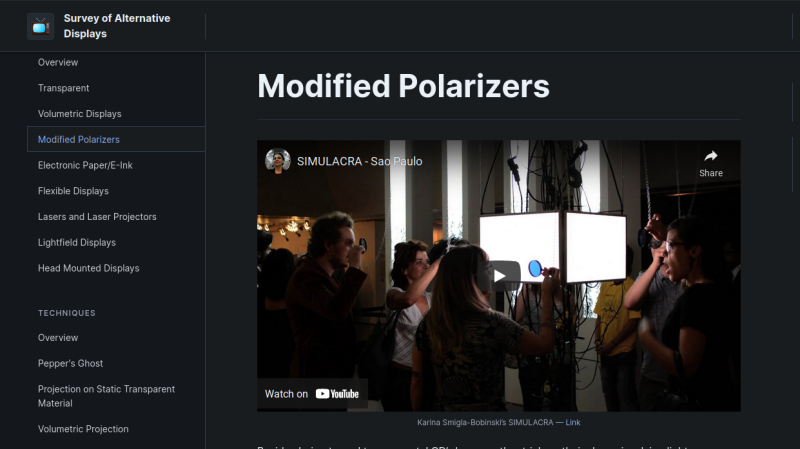[Blair Neal] has been working on an information database for artists and hackers – a collection of non-conventional display technologies available to us. We’ve covered this repository before, six years ago – since then, it’s moved to a more suitable platform, almost doubled in size, and currently covers over 40+ display technology types and related tricks. This database is something you should check out even if you’re not looking for a new way to display things right now, however, for its sheer educational and entertainment value alone.
[Blair] doesn’t just provide a list of links, like the “awesome-X” directories we see a lot of. Each entry is a small story that goes into detail on what makes the technology tick, its benefits and fundamental limitations, linking to illustrative videos where appropriate. It’s as if this guide is meant to give you an extensive learning course on all the ways you can visualize things on your creative journey. All of these categories have quite a few examples to draw from, highlighting individual artworks that have made use of any technology or trick in a particular way.
If you’re ever wondered about the current state of technology when it comes to flexible or transparent displays, or looked for good examples of volumetric projection done in a variety of ways, this is the place to go. It also talks about interesting experimental technologies, like drone displays, plasma combustion or scanning fiber optics. Overall, if you’re looking to spend about half an hour learning about all the ways there are to visualize something, this database is worth a read. And, if there’s a display technology the author might’ve missed and you know something about, contributions are welcome!
Someone setting out to compile information about an extensive topic is always appreciated, and helps many hackers on their path. We’ve seen that done with 3D printer resin settings and SMD part codes, to name just a few. What’s your favourite hacker-maintained database?
















Interesting, but I thought it was going to take me to a web site with info on how to hook up to various displays, such as those found in the surplus market.
Still tryna figure out that Raytheon Radardisplayotron 3000, I tell you you’re going to have to go down to Chile to see how it’s hooked up in one of their 1950s destroyers… bear in mind though it runs off an aux genny off the propulsion diesel and they could never go above 15 knots with the RADAR screens running at the same time…. and forget about getting the rest of the system to tell if the mailman is coming, they put the emitter on a 50ft mast for crew safety, you’re more likely to set his hat on fire.
;-)
Wouldn’t want to take all the fun out of it now would we?
Some great stuff on that from deshipu:
https://hackaday.io/page/5722-driving-oled-displays-directly
https://github.com/deshipu/displays/wiki
Thank you!
I’ve been looking for transflective screens, but haven’t found widely available displays (ideally bigger than 8″). Is this technology dead?
They are now called fluidflective displays, because, you know…
They are around, but have a niche. Reflective displays are much cheaper and transmissive displays have much better color and dark viewability. They have mostly been displaced by transmissive displays with ultra-bright backlighting.
They are a specialty item and there are a few people focused on a version made with modified standard displays that utilizes a partial or complete reflective layer that is bonded to the back of the LCD. I have see 55” versions. Not the same as the original dedicated displays but this is what you get in the commodity electronics space.
One display type I don’t see in the list is the waterfall type sometimes seen in airports or train stations, where a series of parallel valves are opened and closed with careful timing to display some text, or pattern as each drop falls to the ground.
A good example is the one in Osaka’s train station.
https://www.youtube.com/watch?v=5xbozdGlUcs
Ooh good note – i should add that to the physical/mechanical displays maybe. thanks!
Thank you so much for featuring my resource! If an editor sees this – I just wanted to request a spelling correction on the first sentence to Blair Neal (instead of Nearl) – thank you!
Make a comment that is politically incorrect.
They’ll be sure to see it!
B^)
(I also clicked “Report Comment” on your comment to signal the moderator)